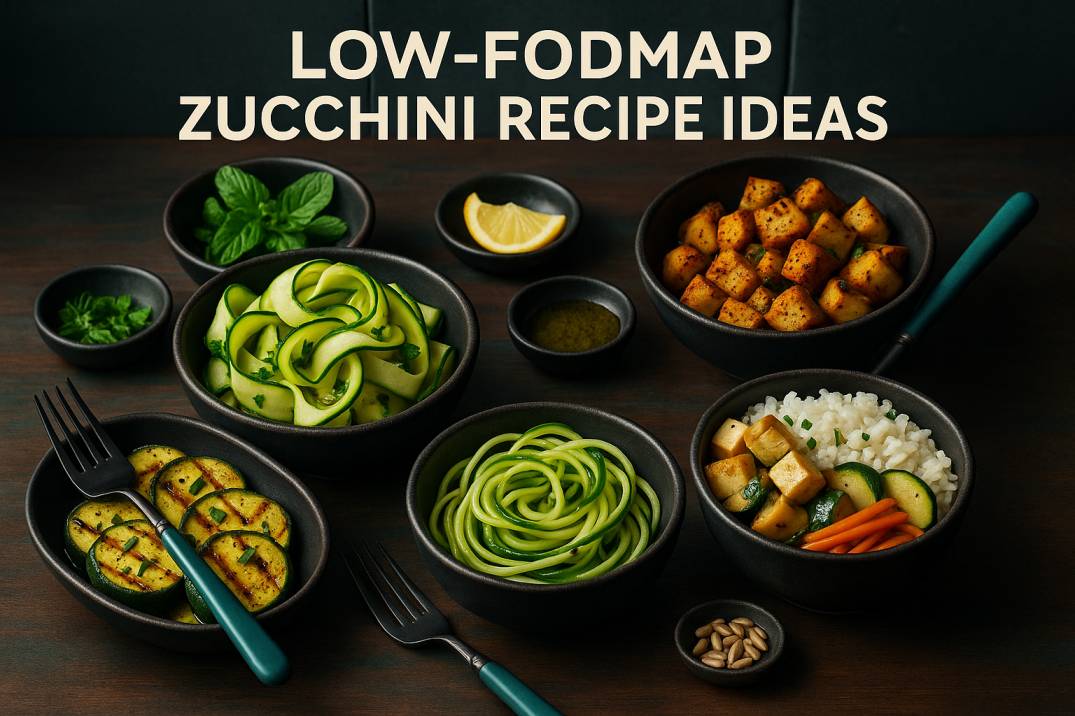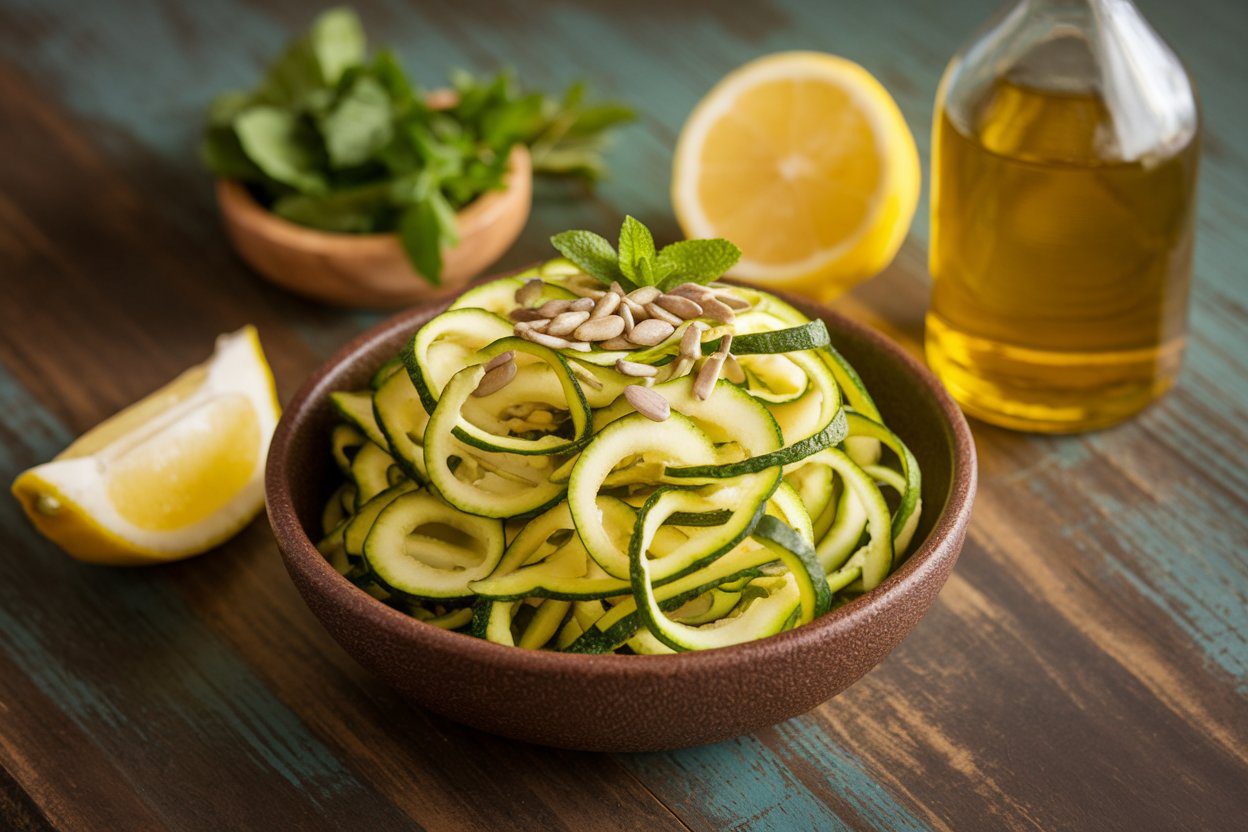Many people on a low-FODMAP diet wonder if zucchini is safe. You might ask: “Can I enjoy zucchini without triggering IBS symptoms?” The answer is yes. Zucchini is low in FODMAPs when consumed in typical portions. In this post, you’ll find clear guidance on portion sizes, nutritional benefits, preparation tips, recipe ideas, and storage advice. You’ll also see how to use zucchini in IBS-friendly meals that deliver flavor and variety.
Link to Monash University’s FODMAP resources for reference: Monash Low FODMAP resources.
Explore related recipes on TummyVibes:
Table of Contents
FODMAP Profile & Portion Guidance
Zucchini contains minimal fermentable carbohydrates when eaten in moderate amounts. Monash University testing shows zucchini is low-FODMAP at servings up to approximately 65–75 grams (around half a small zucchini) per meal. Larger portions may introduce higher levels of fructans or mannitol that some individuals cannot tolerate.
- Safe portion: Aim for about 65 g raw zucchini (roughly half of a medium zucchini, sliced).
- Signs to watch: If you tolerate that well, you may test up to 100 g in one sitting, but add gradually and monitor symptoms.
- Meal spacing: If you include larger servings or multiple FODMAP-containing foods, leave at least 3–4 hours before the next meal with potential FODMAPs.
Ask yourself: Have you tested zucchini in isolation first? If not, start with a small serving and note how your gut responds. Individual tolerance varies.

Nutritional Benefits of Zucchini for IBS
Zucchini offers nutrients that support overall health and may aid digestive comfort when used appropriately:
- Hydration: High water content helps maintain fluid balance.
- Fiber: Contains both soluble and insoluble fiber. In low-FODMAP portions, fiber supports bowel regularity without overloading fermentable carbs.
- Vitamins: Provides vitamin C and small amounts of vitamin A precursors. These support immune function and cellular health.
- Minerals: Supplies potassium, which helps maintain electrolyte balance.
- Low calorie: Adds volume to meals without excess calories, helping with satiety.
You get these benefits without high FODMAP load. Many find zucchini gentle for their gut when prepared simply.
How to Prep Zucchini Safely & Flavorfully
Preparation choices affect both digestibility and taste. Use methods that maximize flavor while avoiding added FODMAP triggers.
Peel or Leave Skin?
- Skin on: Zucchini skin is low-FODMAP and contains fiber. If you tolerate fiber well, leave skin on for texture.
- Skin off: If you notice digestive discomfort with fibrous skins, peel thinly before cooking.
Cooking Methods
- Sauté in Garlic-Infused Oil
- Heat garlic-infused oil in a pan.
- Add sliced or diced zucchini.
- Season with low-FODMAP herbs (e.g., oregano, thyme, basil) and salt/pepper.
- Cook until edges brown lightly and interior is tender.
- Finish with a squeeze of lemon juice.
- Example recipe: Tofu Rice Bowl with Zucchini uses this approach.
- Roasting
- Preheat oven to 200°C (400°F).
- Toss zucchini pieces in olive oil, herbs (rosemary or thyme), salt, and pepper.
- Spread on a baking sheet, ensuring pieces don’t overlap.
- Roast 15–20 minutes until lightly golden.
- Add a sprinkle of safe spices (paprika, ground cumin) after roasting for extra flavor.
- Grilling
- Slice zucchini lengthwise into ribbons or rounds.
- Brush with olive oil and season with salt, pepper, and herbs.
- Grill on medium heat 2–3 minutes per side until grill marks appear.
- Serve with a drizzle of lemon-olive oil and chopped chives.
- Steaming or Boiling (Gentle)
- Steam slices just until tender (3–5 minutes).
- Drain well to avoid excess moisture.
- Dress with garlic-infused oil, herbs, and lemon.
- Use in salads or as a side.
- Raw Preparations
- Slice thinly into ribbons (use a peeler).
- Toss with lemon juice, olive oil, chopped mint or chives.
- Add safe seeds (sunflower seeds) for crunch.
- Use in salads or as a “noodle” base (zoodles).
Seasoning Tips
- Garlic-Infused Oil: Provides garlic flavor without fructans. Use 1 tbsp for sautéing or dressing.
- Herbs: Fresh or dried oregano, thyme, basil, rosemary in small amounts. Chives or green onion tops add mild onion flavor.
- Citrus: Lemon or lime juice brightens flavors.
- Spices: Paprika, ground cumin, ground coriander in small pinches. Avoid spice blends with onion/garlic powder.
- Acidic Additions: A dash of vinegar (apple cider or white wine vinegar) can complement zucchini dishes.
Personal Anecdote
I often slice zucchini into ribbons, toss with lemon and chives, and pack it as a light side on warm days. The texture feels refreshing, and I rarely notice any digestive upset when I stick to half a zucchini. Give it a try and see how you feel.

Low-FODMAP Zucchini Recipe Ideas
Below are several recipes or concepts to inspire you. Link to full recipes when available or adapt existing ones.
1. Zucchini & Tofu Rice Bowl
- Concept: Use sautéed zucchini and tofu over rice or quinoa.
- Method: Sauté tofu cubes in garlic-infused oil, remove; then sauté zucchini slices with herbs; combine and serve over rice with chopped chives and a lemon wedge.
- Link: Tofu Rice Bowl with Zucchini
2. Zoodle Salad with Lemon & Mint
- Concept: Raw zucchini ribbons as “noodles” tossed in light dressing.
- Method: Peel zucchini into ribbons, toss with olive oil, lemon juice, chopped mint or basil, a few sunflower seeds, salt, and pepper. Serve chilled.
- Portion: Keep ribbons to ~65 g zucchini per serving; add greens sparingly if desired.
3. Roasted Zucchini & Bell Pepper Stir-Fry
- Concept: Combine zucchini with low-FODMAP bell pepper for a colorful side.
- Method: Roast zucchini and red bell pepper strips in olive oil, season with thyme and paprika. Return to pan, finish with garlic-infused oil drizzle. Serve with protein (chicken or fish).
- Adaptation: If you have a Chicken Stir-Fry recipe, add zucchini in the last few minutes of cooking.
4. Grilled Zucchini Skewers
- Concept: Skewer zucchini pieces (and safe vegetables like cherry tomatoes) for grilling.
- Method: Marinate zucchini chunks in olive oil, herbs, and lemon juice. Skewer and grill briefly. Serve with a yogurt-based dip (lactose-free yogurt + chives).
- Note: Keep zucchini portions moderate.
5. Zucchini & Herb Frittata (Egg-Based Dish)
- Concept: Use grated zucchini in an egg frittata for breakfast or brunch.
- Method: Lightly sauté grated zucchini in garlic-infused oil, whisk eggs with lactose-free milk, pour over zucchini, bake until set. Season with chives and parsley.
- Portion: Limit zucchini to low-FODMAP portion per serving; balance eggs and lactose-free milk quantities.
6. Zucchini & Carrot Ribbon Salad
- Concept: Combine zucchini ribbons with carrot ribbons for color and texture.
- Method: Peel zucchini and carrot into ribbons, toss with lemon-olive oil dressing, chopped mint, and a small handful of sunflower seeds.
For each idea:
- Test portion first.
- Adjust seasonings to your taste.
- Pair with lean protein or Safe Staples grains as needed.
- Link to related TummyVibes posts: e.g., Low FODMAP Zucchini & Carrot Ribbon Salad.
Storage & Batch Prep
Preparing zucchini ahead can save time and ensure you have IBS-friendly ingredients on hand.
- Pre-Slicing: Slice or ribbon zucchini, store in airtight container in fridge for up to 1–2 days. Pat dry before use to avoid sogginess.
- Roasted Batch: Roast a tray of zucchini strips; cool and refrigerate up to 2 days. Use in bowls, salads, or reheated sides.
- Frozen Prep: Blanch zucchini slices briefly, drain, and freeze in single-layer on a tray. Transfer to freezer bag once solid. Use in cooked dishes (soups or stews) later, but note texture softens.
- Herb Prep: Chop safe herbs (mint, chives) in advance; store in small containers.
- Dressing Ready: Mix lemon-olive oil dressing in a jar; keep refrigerated for up to 3 days. Shake and use when needed.
Batch prep helps you avoid last-minute decision fatigue and ensures you stick to safe portions.
Common Questions
Can I eat zucchini skin?
Yes. The skin is low-FODMAP in typical servings. If you notice digestive discomfort from fiber, peel part of the skin but test slowly.
What about zucchini seeds?
Seeds in typical zucchini are small and not an issue at low-FODMAP portions. If you have a very sensitive gut, you can scoop seeds out before cooking.
Does cooking method affect FODMAP content?
Cooking does not create FODMAPs. It may change texture and water content. Steaming or sautéing in garlic-infused oil is safe. Avoid adding high-FODMAP ingredients (onion, garlic solids, high-FODMAP sauces).
Can I combine zucchini with other low-FODMAP vegetables?
Yes. For example, mix with carrots, bell peppers (red), spinach, or eggplant in low-FODMAP portions. Track overall meal FODMAP load by keeping each ingredient within its safe portion.
What if I accidentally eat more than the safe portion?
Individual tolerance varies. Monitor your symptoms. If mild discomfort occurs, adjust portion next time. Spread zucchini intake across meals rather than all at once.
Next Steps & Further Reading
- Try one of the recipe ideas above this week. Note how you feel after eating.
- Explore other “Ingredient Deep Dive” topics on TummyVibes for bell peppers, carrots, and other low-FODMAP vegetables.
- Bookmark Monash University’s FODMAP resources for up-to-date testing results.
- Join our newsletter for more IBS-friendly tips and recipes.
If you don’t yet have a dedicated zucchini recipe on your site, consider publishing one following the TummyVibes recipe format. Link it here so readers can click directly from this deep dive.
Zucchini is a versatile, gentle vegetable you can enjoy on a low-FODMAP diet. With mindful portions and simple prep methods, you can add zucchini to salads, bowls, grills, and more. Use the ideas above to bring flavor and variety into your IBS-friendly meal plan. You’ll find that zucchini can be a staple ingredient that supports both digestive comfort and enjoyable eating. Enjoy experimenting—and let us know your favorite zucchini creations!

